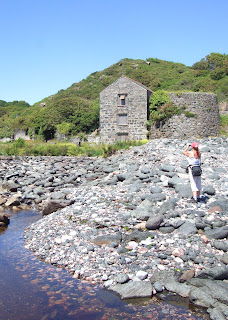 Serpentine is the beautiful stone found at the foot of the
Lizard peninsula, Cornwall's most southerly point. Though it occurs
elsewhere, the Cornish variety is uniquely coloured; dark green, red or grey,
run through with contrasting seams, it polishes like marble to a wonderfully
deep sheen.
Serpentine is the beautiful stone found at the foot of the
Lizard peninsula, Cornwall's most southerly point. Though it occurs
elsewhere, the Cornish variety is uniquely coloured; dark green, red or grey,
run through with contrasting seams, it polishes like marble to a wonderfully
deep sheen.For centuries, serpentine-bearing blocks were used to build the Lizard’s homes and farm buildings. Local people also carved small decorative objects but it was a Mr Drew who first saw business possibilities for ornamental items, when he arrived in 1828 to repair the peninsula’s lighthouse. The rock’s glorious tones must have caught his eye; he developed a polishing technique to buff it to a fine lustre, and opened a concern in his home town of Penzance which cut and carved serpentine items commercially.
A second factory soon opened nearby, at Wherrytown, also in Penzance; at first, orders were taken for items such as pedestals, vases, flower stands and mantelpieces. But a boost came in 1846, when Queen Victoria and Prince Albert called at the town aboard the royal yacht. Ashore, they were shown specimens of polished serpentine.
Enchanted by the colours, the royal holidaymakers made an unscheduled visit to see the rock in its natural surroundings. They ordered many serpentine items for their Osborne House residence, including several mantelpieces and twelve polished vase bases. News of the stone travelled among the great-and-good of the land; with royal approval, serpentine grew as a fashionable material.
During 1851 the Great Exhibition was held in Hyde Park, an enormous show of culture and industry; from May to October, six million people visited. Serpentine was exhibited there, bringing the unfamiliar rock before a huge audience. Business soared; to represent the stone in the capital, the London and Penzance Serpentine Company was formed.
Orders arrived for ever-larger pieces: towering obelisks, columns, ecclesiastical pieces, fireplaces. Cornish serpentine found its way to Chatsworth House, Hampton Court and Westminster Abbey. Across Britain, the stone decorated the exteriors of municipal buildings and prominent shops. Locally, serpentine was used to create ornamental items within the Lizard’s churches, including lecterns and pulpits at Grade and St Wynwallow.
In 1853 the Lizard Serpentine Company was founded, on the peninsula close to the stone, in tiny Poltesco valley; it too opened a London office. Whereas Wherrytown used a steam engine to power its processing machinery, at first Poltesco relied on a waterwheel driven by the stream which ran through the valley; later, it acquired an engine of its own.
The two factories were great rivals, but there seemed enough work to go round. Quarrying increased, all within a few miles of Lizard Village. The raw serpentine was hewn in ever larger slabs; blasting damaged the material, so instead jacks, wedges and cranes were used.
But gradually a problem emerged with some of the veneers adorning building exteriors. Serpentine wasn’t sufficiently resilient in the face of severe cold or frost, and away from the Lizard’s gentle climate the thin sheets began to flake and crack. Serpentine’s critics, not least those from the rival marble trade, lost no time in hand-wringing.
Wherrytown put up the shutters but its rival continued, buoyed temporarily by the closure; during 1871 a change of ownership created the Poltesco Serpentine Marble Company. Finally though, in 1893, the Lizard enterprise closed down too. Processing and manufacturing equipment was sold off, the workforce left and the valley fell silent.
That might have been the end of the story, but as serpentine’s large-scale uses fell into decline, a new market emerged for items which could be made by small workshops: the tourist trade. By the 1880s, amongst its myriad routes the Great Western Railway had opened a branch line to Helston, the Lizard’s northernmost point. Later an omnibus connection appeared between Helston and Lizard Village.
Holidaymakers eagerly bought serpentine keepsakes: ash-trays, paperweights, tobacco jars. Tourism developed into a mainstay of Cornwall’s economy, and demand for souvenirs grew. The serpentine workers improved their artistry, creating bowls, miniatures and vases as well as elegant lighthouses, symbolic reminders of the seas around the Duchy’s long coastline.
Today a handful of craftsmen still work at Lizard Village and local showrooms sell serpentine pieces. Poltesco valley shows evidence of its former use; the three-storey warehouse built in 1866 remains, as well as workshop footings and the waterwheel pit, during springtime surrounded with vivid wild flowers.
The best place on the Lizard to see serpentine in its raw state is Kynance Cove, where the pounding sea’s natural polish has fashioned and smoothed the rocks, leaving them gleaming as it recedes. Against the soft white sand, Cornish serpentine stands out rich and unique.




3 comments:
Fascinating. Very good article.
i have seen the stone in the raw being carved on an old lath and then polished
there was an old fellow doing it at church cove i expect that he maybe there any more
we worth the visit
in 1993 I visited the Lizard - as enchanting a place as anywhere - and on my last day there purchased a small red serpentine vase. Very small, about 3" high. The cost seemed exorbitant - 50 pounds sterling! I was told that the red variety only developed below the water's surface. Mining could occur only at very low tides. Made a good story for a gullible tourist! Still wonder if it's true?
Post a Comment